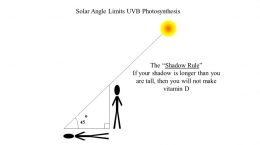Published on May 25, 2021
Red, Near Infrared, Far Infrared, and Blue Light from sunshine may all have unique health effects to offer
 We have previously discussed the health effects of ultraviolet radiation from sunshine, including UVA and UVB radiation. UVB light leads to vitamin D synthesis and can be used as a main source of vitamin D. UVA leads to the release of nitric oxide into the bloodstream which in turn benefits the cardiovascular and metabolic systems, and may offer other immunological benefits beyond those offered by nitric oxide.
We have previously discussed the health effects of ultraviolet radiation from sunshine, including UVA and UVB radiation. UVB light leads to vitamin D synthesis and can be used as a main source of vitamin D. UVA leads to the release of nitric oxide into the bloodstream which in turn benefits the cardiovascular and metabolic systems, and may offer other immunological benefits beyond those offered by nitric oxide.

There are other wavelengths of energy from the sun that can reach the earth’s surface and provide health benefits besides UVA and UVB. Some of these are reviewed in a paper by Heiskanen et al. and summarized below.
Overview of Solar Radiation
The solar spectrum consists of different forms of radiation or energy with wavelengths between 300 nm and well over 1 mm. Not all of this radiation is able to penetrate the earth’s atmosphere to reach the earth’s surface. Those that do have a wavelength between 100 nm and 1mm, and include ultraviolet radiation (100-400 nm), visible light (400-700 nm), and infrared light (700 nm to over 1 mm).
Just as some of this spectrum is able to make it through the atmosphere, different wavelengths are also able to penetrate the skin to different depths of the body’s tissues and may have certain effects on the cells within those tissues.
Those at the higher wavelengths are able to penetrate deeper. UVB (295-319 mn) is at the bottom end of the sunlight spectrum is able to reach the surface of the earth, and therefore our skin, only at specific times and locations. UVB is not able to penetrate beyond the very surface of the skin. UVA (320-399 nm) exists at a wavelength between UVB and visible light, and is able to reach the deeper levels of the skin but not much further, while visible light can go deeper. Think of how you are able to see the light from a flashlight on the back of your hand when held against the skin on the palm of the hand – you can visually see the energy traveling through the skin, muscles, blood vessels and tissues of the hand!
Beneficial Effects of Red Light and Near-Infrared Radiation
Photobiomodulation is a term used to describe the physiological effects from irradiation by red or near-infrared wavelengths. Red and near-infrared wavelengths have the ability to penetrate inside of our body’s tissues and cells, and can even penetrate through thin clothing. Studies have shown such benefits include improved tissue function, wound healing, anti-inflammatory effects, and improved energy metabolism from red and near-infrared wavelengths. Conditions that may benefit from photobiomodulation include allergies, hypothyroidism, depression, dementia, cancer, diabetes related symptoms, exercise performance and recovery, pain, and cardiovascular diseases. One of the proposed mechanisms is with the involvement of the mitochondria, since changes in ATP levels have been an observed outcome of red and near-infrared radiation.
How Blue Light Affects Us
Blue light (460 nm) is another form of energy from sunlight that has potential health benefits. Studies have shown that blue light has the strongest effect on the suppression of melatonin secretion upon exposure to the eyes, which could contribute to the regulation of circadian rhythm. Blue light may also play a role in the improvement of mood and depression, both seasonal and non-seasonal. Other physiological actions of blue light suggested by studies include an increase in circulating beta endorphins, decreased systolic blood pressure due to nitric oxide mechanisms in the skin, and a potential biomodulating effect within the cells.
Far-infrared Radiation May Offer Benefits Beyond Thermal Effects
Far infrared radiation (FIR) is at the far end of the solar spectrum of energy that reaches the earth’s surface, opposite of UVB, with the longest wavelength. Studies suggest that the cardiovascular system especially may benefit from FIR. Reported effects of FIR include blood pressure regulation, improved depressive symptoms, endothelial function, microcirculation, the formation of new blood vessels, wound healing, and increased flow-mediated dilation of the blood vessels, although some of these effects may be attributed solely to the thermal effects of FIR.
Are You Getting Enough Sunlight for Your Health?
Measuring your vitamin D level is one way to tell if your body is getting enough sunlight, and correcting a vitamin D deficiency at any age and any time of life can decrease potential disease severity and improve outcomes. With almost 90% of the general population having vitamin D levels below the recommended 40-60 ng/ml (100-150 nmol/L), it is obvious that most people need more vitamin D. While most of us cannot achieve a vitamin D level of 40-60 ng/ml from sun alone, either due to our lifestyle, where we live, or other circumstances, we can certainly reach those levels with the right amount of supplementation.
Below is a guide for how much you might need, and who may need more. Your levels can be tested safely at home – order your home test kit today.
By joining the GrassrootsHealth projects, you are not only contributing valuable information to our study, but you are also gaining knowledge about how you could improve your own health through measuring and tracking your nutrient status, and educating yourself on how to improve it. Do you know what your status of vitamin D, omega-3s, and other essential nutrients is? Could your levels be improved? Test now to find out!
 We now have a NEW GIFTING SERVICE that allows you to quickly send ‘Gift Cards’ to friends, family and coworkers who you consider might need immediate access to testing, and to Claim the Joy of Your Health TODAY. Give the gift today!
We now have a NEW GIFTING SERVICE that allows you to quickly send ‘Gift Cards’ to friends, family and coworkers who you consider might need immediate access to testing, and to Claim the Joy of Your Health TODAY. Give the gift today!









